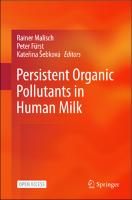Persistent Organic Pollutants in Human Milk
| dc.contributor.editor | Malisch, Rainer | |
| dc.contributor.editor | Fürst, Peter | |
| dc.contributor.editor | Šebková, Kateřina | |
| dc.date.accessioned | 2023-10-13T15:43:33Z | |
| dc.date.available | 2023-10-13T15:43:33Z | |
| dc.date.issued | 2023 | |
| dc.identifier | ONIX_20231013_9783031340871_13 | |
| dc.identifier | OCN: 156977236 | |
| dc.identifier.uri | https://library.oapen.org/handle/20.500.12657/76720 | |
| dc.description.abstract | This open access book reviews the trends of persistent organic pollutants (POPs) in human milk and discusses the main findings of five global surveys that were coordinated by the World Health Organization (WHO) and the United Nations Environment Programme (UNEP) from 2000 to 2019. Human milk was selected as core matrix for human exposure under the Global Monitoring Plan for effectiveness evaluation of the Stockholm Convention on Persistent Organic Pollutants. Milk from well-defined groups of mothers was collected and mixed to form a representative sample per country. Datasets collected represent the largest global human tissues survey with a harmonized protocol, carried out in a uniform format for more than two decades. Altogether 69 countries participated in these studies between 2000 and 2015, and more than 40 countries participated in the study from 2016 to 2019. Divided into 5 parts, the book offers an authoritative overview of human milk biomonitoring; collates the harmonized sampling requirements and analytical methods for the identification and quantification of contaminants in human milk; examines the results of the WHO/UNEP-coordinated exposure studies, including the identification of selected chlorinated pesticides, dioxin-like compounds, industrial chemicals like polychlorinated biphenyls (PCB) and chlorinated paraffins, polybrominated POPs and PFAS, among others; and traces geographic, temporal and cross-substance trends and correlations, and human health risks. The book finishes by providing the reader with the summary of the main findings and outlook from these studies, in which the comparison of concentrations found for the wide range of POPs listed in the Stockholm Convention allowed the identification of possible needs for actions and follow-ups in different countries/regions. This book contributes to the understanding of exposure to hazardous chemicals and pollution as addressed by the UN Sustainable Development Goals on Good Health and Well-being (SDG 3) and will appeal to environmental and analytical chemists, researchers, professionals, and policymakers interested in learning more about contaminants in human milk. Given its breadth, this book will also appeal to a broader audience interested in maternal and child health. | |
| dc.language | English | |
| dc.subject.other | Persistent organic pollutants | |
| dc.subject.other | Biomonitoring Human Milk | |
| dc.subject.other | Contaminants in Human Milk | |
| dc.subject.other | Chlorinated Paraffins | |
| dc.subject.other | Chlorinated Pesticides | |
| dc.subject.other | Human health risks | |
| dc.subject.other | Maternal and Child Health | |
| dc.subject.other | Polybrominated and Perfluoroalkane substances | |
| dc.subject.other | Polychlorinated biphenyls | |
| dc.subject.other | Polychlorinated dibenzofurans | |
| dc.subject.other | Polychlorinated dibenzo-p-dioxins | |
| dc.subject.other | Polychlorinated naphtalenes | |
| dc.subject.other | United Nations Environment Programme | |
| dc.subject.other | WHO/UNEP-coordinated global survey of human milk | |
| dc.subject.other | World Health Organization | |
| dc.title | Persistent Organic Pollutants in Human Milk | |
| dc.type | book | |
| oapen.identifier.doi | 10.1007/978-3-031-34087-1 | |
| oapen.relation.isPublishedBy | 6c6992af-b843-4f46-859c-f6e9998e40d5 | |
| oapen.relation.isFundedBy | 4a5a7596-772d-4155-bdeb-4a7408ea40f0 | |
| oapen.relation.isbn | 9783031340871 | |
| oapen.relation.isbn | 9783031340857 | |
| oapen.imprint | Springer International Publishing | |
| oapen.pages | 683 | |
| oapen.place.publication | Cham | |
| oapen.grant.number | [...] |

